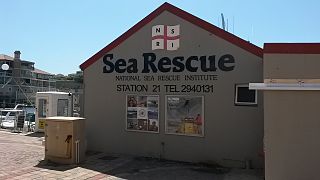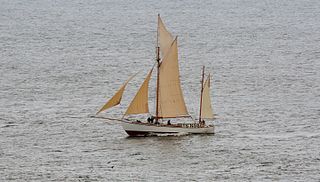
Search and rescue (SAR) is the search for and provision of aid to people who are in distress or imminent danger. The general field of search and rescue includes many specialty sub-fields, typically determined by the type of terrain the search is conducted over. These include mountain rescue; ground search and rescue, including the use of search and rescue dogs ; urban search and rescue in cities; combat search and rescue on the battlefield and air-sea rescue over water.

The Royal National Lifeboat Institution (RNLI) is the largest of the lifeboat services operating around the coasts of the United Kingdom, the Republic of Ireland, the Channel Islands, and the Isle of Man, as well as on some inland waterways.

The Canadian Coast Guard is the coast guard of Canada. Formed in 1962, the coast guard is tasked with marine search and rescue (SAR), communication, navigation, and transportation issues in Canadian waters, such as navigation aids and icebreaking, marine pollution response, and support for other Canadian government initiatives. The Coast Guard operates 119 vessels of varying sizes and 23 helicopters, along with a variety of smaller craft. The CCG is headquartered in Ottawa, Ontario, and is a special operating agency within Fisheries and Oceans Canada.

Colin Archer was a Norwegian naval architect and shipbuilder known for his seaworthy pilot and rescue boats and the larger sailing and polar ships. His most famous ship is the Fram, used for both Fridtjof Nansen's and Roald Amundsen's polar expeditions.

Capsizing or keeling over occurs when a boat or ship is rolled on its side or further by wave action, instability or wind force beyond the angle of positive static stability or it is upside down in the water. The act of recovering a vessel from a capsize is called righting. Capsize may result from broaching, knockdown, loss of stability due to cargo shifting or flooding, or in high speed boats, from turning too fast.

SSNorge was a transatlantic ocean liner that was launched in 1881 in Scotland, and lost in 1904 off Rockall with great loss of life. Her final voyage was from Copenhagen, Kristiania and Kristiansand, bound for New York, carrying passengers many of whom were emigrants. It was the biggest civilian maritime disaster in the Atlantic Ocean until the sinking of Titanic eight years later, and is still the largest loss of life from a Danish merchant ship.

The Swedish Sea Rescue Society, formally the Swedish Society for the Saving of Shipwrecked Persons is a Swedish voluntary organisation that works with maritime search and rescue on Swedish lakes and seas. The society runs 70 lifeboat stations, with over 200 rescue vessels and over 2100 volunteers. Of these, more than 300 are on call at any given moment, and can respond to an emergency call within 15 minutes. It is a member of the International Maritime Rescue Federation (IMRF)

The German Maritime Search and Rescue Service is a membership organisation in Germany. It is responsible for Search and Rescue in German territorial waters in the North Sea and the Baltic Sea, including the Exclusive Economic Zone.
RS Sjøfareren is the largest lifeboat in use by the Norwegian organization Norwegian Society for Sea Rescue.

The Biskop Hvoslef is a veteran Norwegian sailing vessel. The vessel was named after Bishop Waldemar Hvoslef (1825-1906). Bjarne Aas designed the vessel which was his first rescue boat. The ship was built for the rescue company of Br. Fallfall in Hardanger and put into service in 1933. The ship was utilized as a search and rescue by the Redningsselskapet on the Norwegian coast between 1933 and 1969. It is now a privately owned vessel. In 1992, "Biskop Hvoslef" was bought by the Balsfjord village museum. Later, the retired lifeboat was taken over by a foundation. From 1992, the skate was also on the National Antiquities' list of vessels worthy of preservation, but the conservation status was revoked when the skate changed owners in 2013. It is 16.85 meters long and has a deck width of 5.24 meters.

A lifeboat or liferaft is a small, rigid or inflatable boat carried for emergency evacuation in the event of a disaster aboard a ship. Lifeboat drills are required by law on larger commercial ships. Rafts (liferafts) are also used. In the military, a lifeboat may double as a whaleboat, dinghy, or gig. The ship's tenders of cruise ships often double as lifeboats. Recreational sailors usually carry inflatable liferafts, though a few prefer small proactive lifeboats that are harder to sink and can be sailed to safety.
A rescue lifeboat is a boat rescue craft which is used to attend a vessel in distress, or its survivors, to rescue crew and passengers. It can be hand pulled, sail powered or powered by an engine. Lifeboats may be rigid, inflatable or rigid-inflatable combination-hulled vessels.

The National Sea Rescue Institute (NSRI) is a voluntary non-profit organisation in South Africa tasked with saving lives through drowning prevention. It operates 49 bases comprising coastal stations, inland stations on dams, auxiliary stations and lifeguard units. There are crews on standby at all hours. There are over 1000 volunteers equipped with sponsored rescue craft, rescue vehicles, quad bikes and tractors, supported by an operations department at the head office.
Water safety refers to the procedures, precautions and policies associated with safety in, on, and around bodies of water, where there is a risk of injury or drowning. It has applications in several occupations, sports and recreational activities.

Skomvær was the name of a steel-hulled barque built in 1890 for J. C. & G. Knudsen in Porsgrunn, Telemark, Norway. The ship, which was designed by naval architect Randulf Hansen and constructed at Laxevaags Maskin- og Jernskibsbyggeri in Bergen, was the first sailing ship constructed with steel in Norway and for a time the largest Norwegian sailing vessel ever built. However, the ship struggled to compete in the 20th century with the advent of the steamship, and in 1924 she was decommissioned and sold for scrap.

RNLB Abdy Beauclerk was a 41ft 'Aldeburgh' Type Beach Motor which was stationed in the town of Aldeburgh in the English county of Suffolk. She was on the No: 1 station at Aldeburgh from 1931 until she was sold out of the RNLI fleet in 1959, a total of 28 years service.

Wyvern is a 60-foot (18 m) open sea sailing ship operated by Stavanger Maritime Museum. The ship was designed by Colin Archer on a commission from British-born Frederick Croft and was launched on 10 August 1897. She sailed under the German flag from 1909. The Norwegian newspaper editor Rolf Thommessen bought her in 1924 and renamed her Havfruen III. This name was kept by the English owners, Anne and Terrence Carr, who acquired her in 1947 and sold her to Christian-Frederick Mattner in 1970, who renamed her to the original name "Wyvern".

HNoMS Maud is a replenishment oiler constructed at Daewoo Shipbuilding & Marine Engineering in South Korea. She was built on behalf of the Norwegian Defense Materials Agency Forsvarsmateriell, for service in the Royal Norwegian Navy.
The Marine Rescue Unit, an integral component of the Lebanese Civil Defense, is a dedicated volunteer organization with a primary mission of safeguarding lives in the maritime domain along the Lebanese coastline. In addition to its core life-saving duties, the unit is also entrusted with combating maritime fires and upholding the preservation of the marine environment.

RS 14 Stavanger is a rescue ship built for the Norwegian Society for Sea Rescue in 1901, in accordance to drawings by Colin Archer. She was in service until 1938. In 2018, RS 14 Stavanger became the cover motif of the 500 kroner banknote in the new banknote series that was introduced in 2017.




















